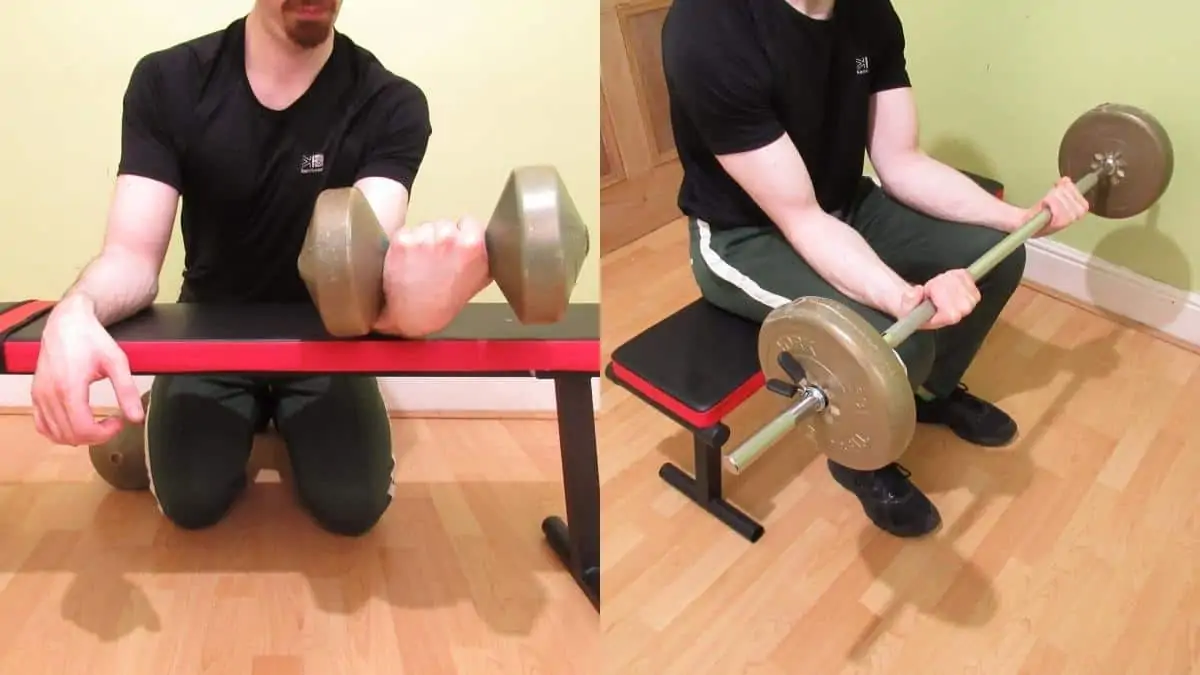This guide covers the best forearm exercises that you can do for mass, size, and overall muscularity. You’ll also find various forearm workouts for strength and general fitness, all of which include sets, reps, and technique advice.
Moreover, you’ll learn how to get bigger forearms safely. As many sports scientists are coming to realize, quality sets that work the target muscles are more important for stimulating muscle growth than countless sets of what’s commonly referred to as junk volume.
Top 10 best forearm exercises for mass
Before we get into the top forearm workouts to include in your strength training regime, let’s explore and analyze the absolute best exercises for forearms that you can possibly do in the gym.
1. Behind the back wrist curl

The behind the back wrist curl earns the number 1 spot on our list because it adds mass to the flexors (the underside of your forearm) like nothing else. Because you can’t see the barbell moving in action, you’re forced to rely on a strong mind-muscle connection, which makes this mass-builder one of the top forearm lifts in existence.
- Place a barbell in a rack at roughly hip height.
- Face away from the bar and then grip the barbell just inside shoulder width.
- Maintain good posture and then lower the barbell by bending your wrists.
- Keep going until you feel a good stretch in the underside of your lower arms.
- Flex your wrists to bring the weight back up, and finish the rep by forcefully contracting your forearms.
- Repeat for 3-4 sets of 8-12 reps. Aim to do this drill first in your forearm workout routine to take advantage of its mass-building prowess.
2. Reverse wrist curl (barbell)

No great forearm workouts are complete without reverse wrist curls. This movement works your wrist extensors (top of your forearm) and is best performed for high reps because the extensors are a very slow-twitch muscle group.
The barbell reverse wrist curl, in particular, is an efficient exercise because you can work both sides of your body at once. Just make sure to lift light weights, to begin with. Even 15-20lbs can give you a killer forearm workout because the extensors respond better to high reps rather than low reps.
- Grab a light barbell just inside shoulder width.
- Rest the underside of your forearms on a weight bench (or your thighs) and let your hands hang off the edge.
- Lower the bar towards the floor by bending your wrists.
- Descend until you feel a deep but comfortable stretch in the top of your forearms.
- Bring the weight back up by extending your wrists towards the ceiling.
- Aim to raise your hands higher than your forearms for the best contraction.
- Repeat for 3-4 sets of 15-20 reps.
3. Single dumbbell wrist curl
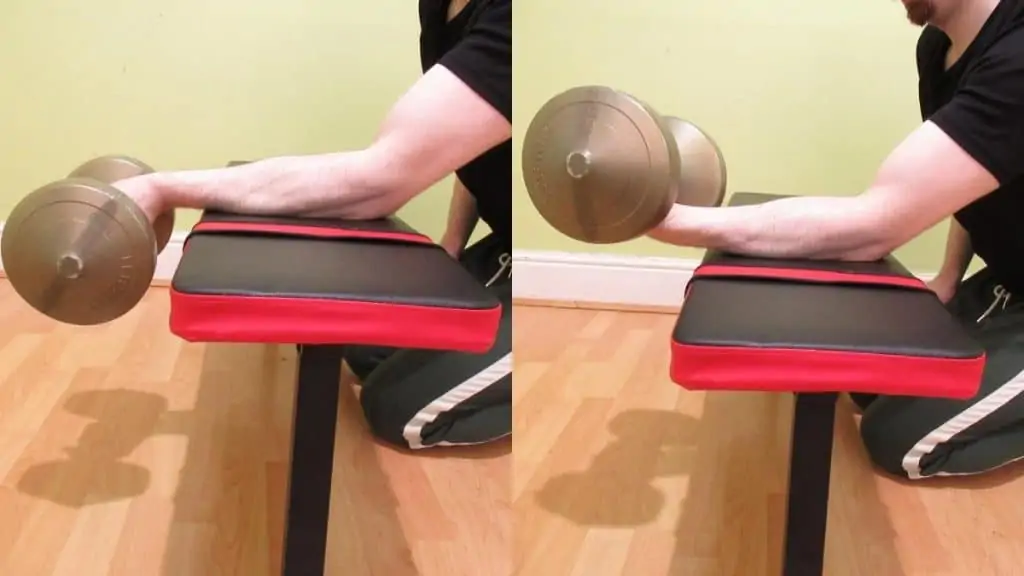
When regular wrist curls start to strain your mind-muscle connection, the single dumbbell wrist curl can come to your rescue. By training one arm at a time, you can naturally devote 100% of your attention to the working muscle.
This means that you’re less likely to make mistakes and get injured. Plus, you’ll also get a much stronger muscle pump because you don’t have to focus on two limbs at once.
The downside, of course, is that training forearms this way takes roughly twice as long.
- Hold a moderately heavy dumbbell in the palm of your hand.
- Rest your forearm on a bench or your thigh in a palm-up position.
- Bend your wrist to lower the weight towards the ground.
- Keep going until you feel a nice stretch.
- Immediately curl the weight back up by flexing your wrist.
- Make sure to squeeze your forearm flexors at the top of the rep.
- Repeat for 2-3 sets of 10-15 reps.
4. Wrist roller
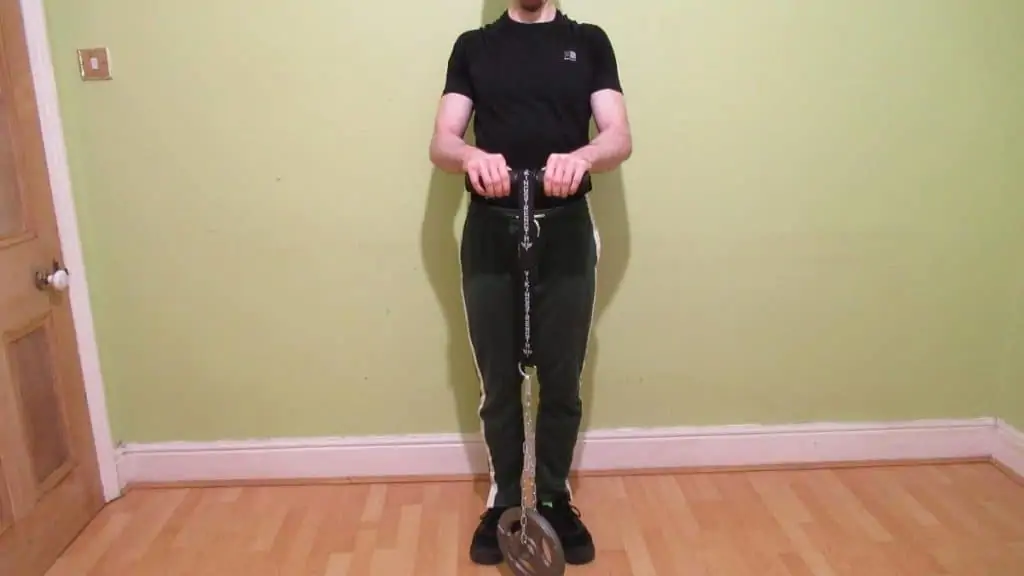
If I could do only one forearm strength exercise, it’d be the wrist roller. Unlike other exercises, this old-school mass builder works both your flexors and extensors and even challenges your grip strength. Plus, you don’t even need to go to the gym to do it.
- Bend your arms to 90-degrees and hold a wrist roller with an overhand grip.
- Keep it close to your body (like you’re doing a curl) rather than holding it out like in a front raise. We don’t want our shoulders to fatigue before our forearms.
- Move the weight up by rotating your wrists backward. Keep going until the weight plates reach the top of the device.
- Lower the weights back down by again rotating your wrists forward. Repeat for 2-3 sets (1 set is one concentric and one eccentric phase)
Remember that rotating the roller backward during the concentric prioritizes your extensors, while rolling it forward works more of your flexors.
Read more: forearm exercises for tennis │baseball forearm workouts
5. Cable wrist curl
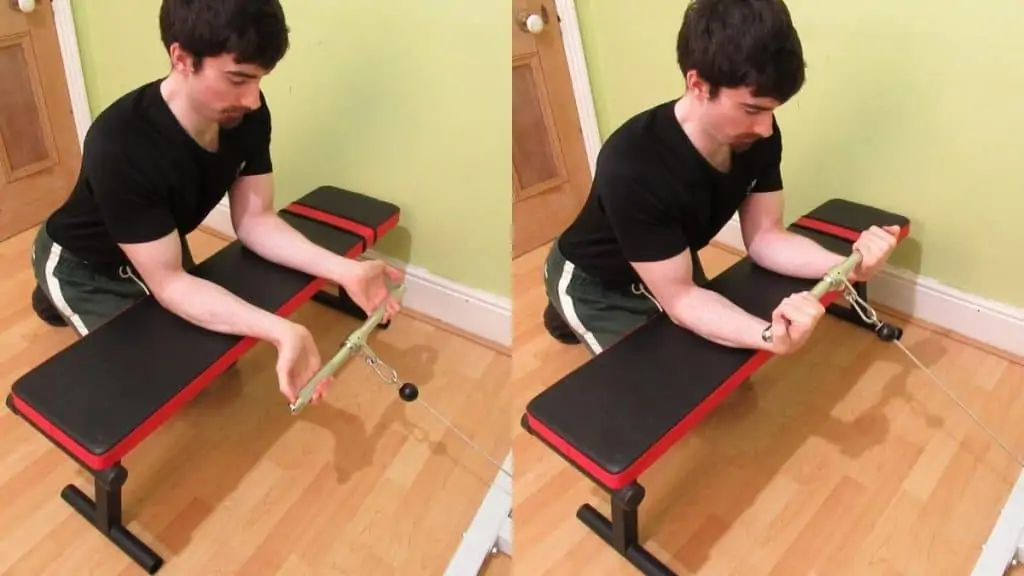
The best forearm workouts should always include the cable wrist curl because it provides constant tension and a virtually unrivaled muscle pump. Also, unlike free weight variations, the cable version is extremely easy to set up because you don’t need to load any weights onto a bar. You just put the pin in the slot and lift.
- Attach a straight bar to a low pulley and grab it slightly inside shoulder width.
- Hold the bar just in front of your body with your elbows fully locked out.
- Curl the bar upwards by flexing your hands towards your forearms.
- Hold the contraction for a second and then lower the bar under control.
- Repeat for 2-3 sets of 10-15 reps.
6. EZ bar wrist curl
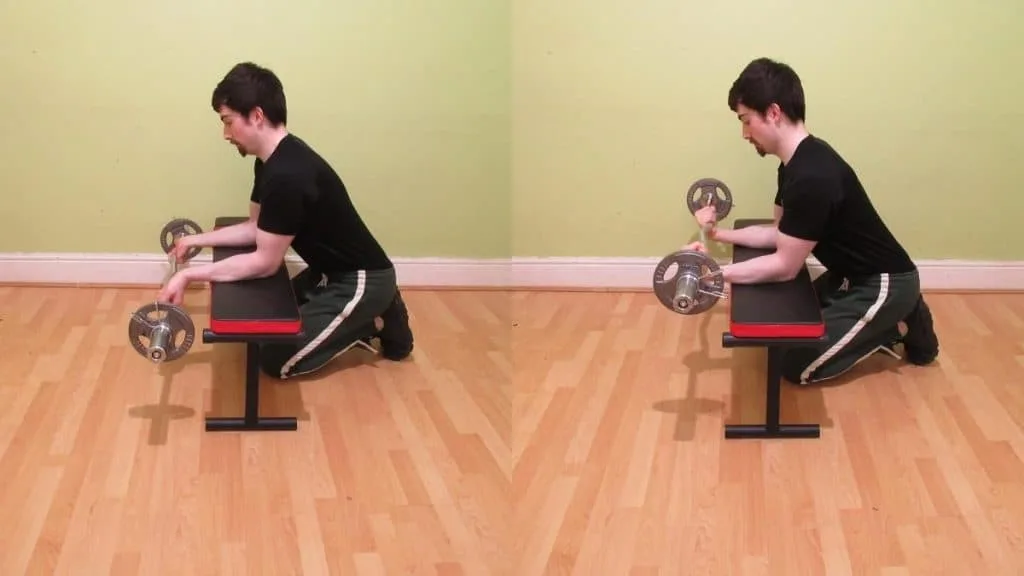
The EZ bar wrist curl is a great replacement exercise if the barbell version hurts your wrists. Thanks to the semi-pronated grip, your muscles naturally take more of the strain than your joints.
- Hold an EZ bar with an overhand grip, just inside shoulder width.
- Rest the underside of your forearms on a bench and allow your wrists to hang off the edge.
- Lower the bar towards the floor by bending your wrists until you feel a good lower arm stretch.
- Come back up by flexing your wrists, and don’t forget to squeeze at the top of the rep.
- Repeat for 3-4 sets of 15-20 reps.
7. Palms down dumbbell wrist curls
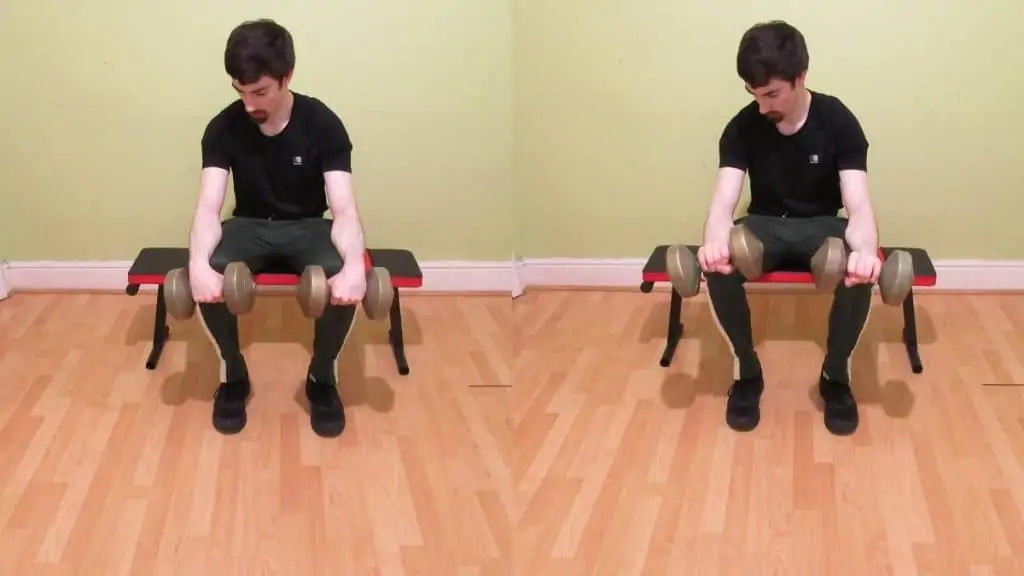
If you want to avoid getting—or worsening existing—muscle imbalances, then palms down dumbbell wrist curls are arguably the best way to work out forearms.
- Hold 2 light dumbbells in the palms of your hands with an overhand grip.
- Rest your forearms (palms down) on a weight bench.
- Let your hands hang off the bench.
- Slowly lower the dumbbells towards the ground until you feel a good stretch.
- Immediately curl the weights back up by extending your wrists.
- Bring the weights up until your hands surpass the height of your forearms.
- Repeat for 2-3 sets of 15-20 reps.
8. Standing wrist curl
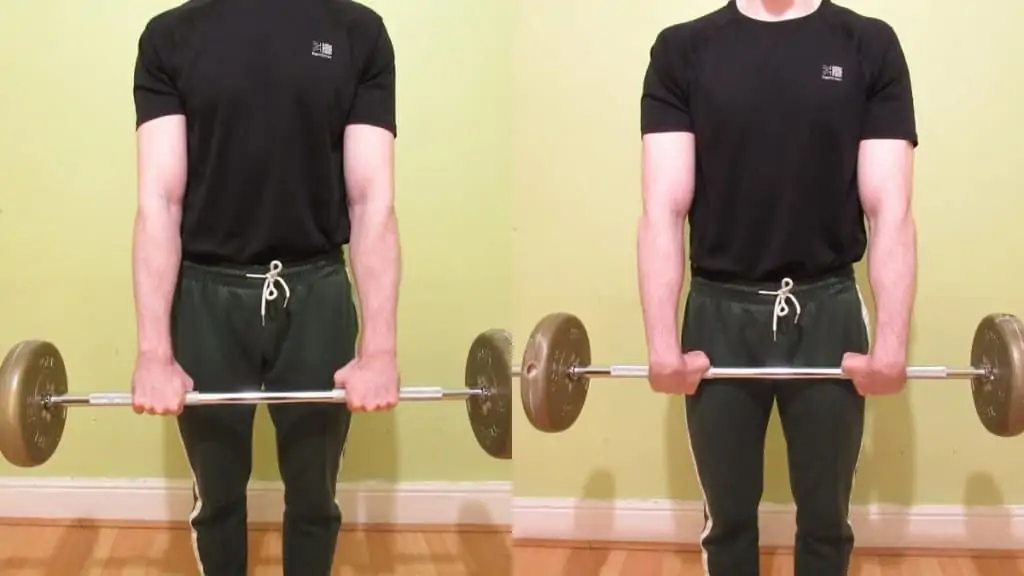
You’ll regularly find the standing wrist curl in some of the best workouts for forearms because it’s an incredibly easy exercise to set up. You don’t need to wait around for a bench to become available, and you don’t need to awkwardly hold a bar behind your back.
It’s commonly regarded as one of the best all-time mass builders for the lower arms.
- Load up a barbell with moderately heavy weight and hold it with an overhand grip, a little inside shoulder width, elbows fully locked out.
- Curl the barbell upwards by flexing your wrists until you feel an intense forearm contraction.
- Hold that contraction for a split second and then slowly lower the weight.
- Repeat for 3-4 sets of 8-12 reps.
9. Plate wrist curl
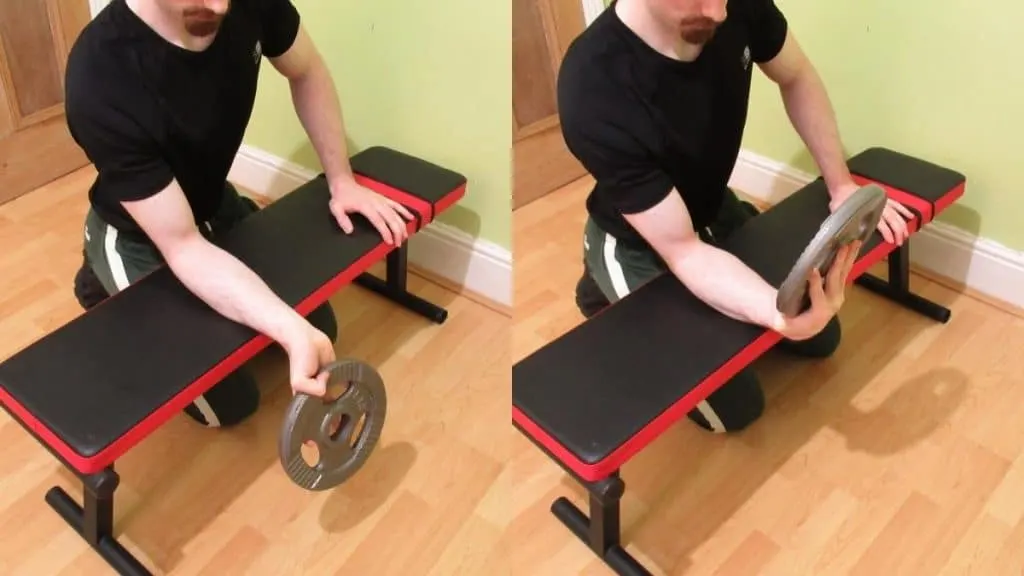
If you just want to get on with your forearm strength training or don’t have dumbbells and barbells available, then the plate wrist curl is a top choice. Unlike other exercises, this drill requires you to use your grip to maintain a firm hold on the weight plate. So you could say that it’s a great cure for a weak handshake, too.
- Hold a weight plate in one hand and then place your forearm, palm up, on a weight bench.
- Bend your wrist towards the floor until you feel a nice muscle stretch.
- Flex your wrist to bring the weight back up. Repeat for 2-3 sets of 8-12 reps.
- Then, hold the plate with an overhand grip (palms down) to work your extensors.
10. Standing reverse wrist curl

If you want to learn how to workout your forearms properly, understand this: Don’t skip wrist extensor training. That’s right, the muscles on top of your forearm (extensors) are critical.
However, many lifters only train their flexors, which leads to poor overall muscle development and symmetry. That’s why I love the standing reverse wrist curl. It’s so easy to set up and execute that you’re much less likely to skip training this crucial muscle group.
- Hold a light barbell with a close-overhand grip, elbows fully locked out.
- Extend your wrists by rotating the bar away from your body.
- Squeeze the tops of your forearms and then slowly lower the weight back to the starting position.
- Stick to high reps (15-20) and do around 2-4 sets.
Read more: kettlebell forearm exercises │forearm exercises for arm wrestling
Best forearm workouts for mass, strength, and definition
The best workout for forearms depends on your ability level. That’s why we’ve created a beginner forearm training routine, a strength-focused plan, and one for maximum muscle mass.
Forearm muscle workout for beginners
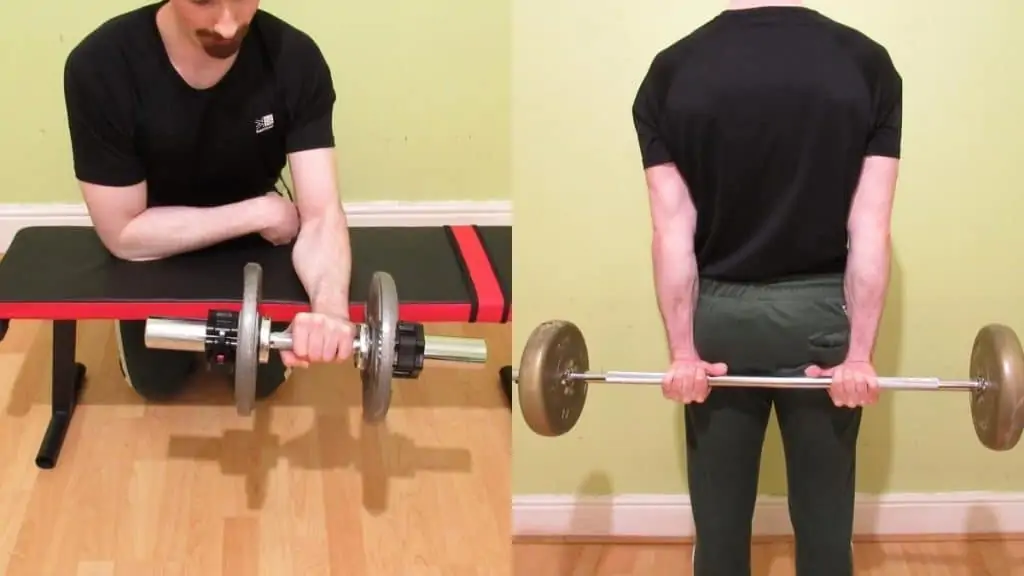
Many forearms workouts are needlessly complicated in order to grab your attention. This one isn’t. With it, you’ll get strong at the basics and earn the forearm size to match your strength.
We start with the lower arms and then do reverse curls, which are one of the top brachioradialis exercises for giving your arms that mesmerizing 3D look.
1: Wrist curl (behind the back) — 3 x 8-12 reps
2: Reverse wrist curl — 3 x 15-20 reps
3: Reverse curl (thumbless grip)— 3 x 8-12 reps
Most muscular forearm workout (advanced)
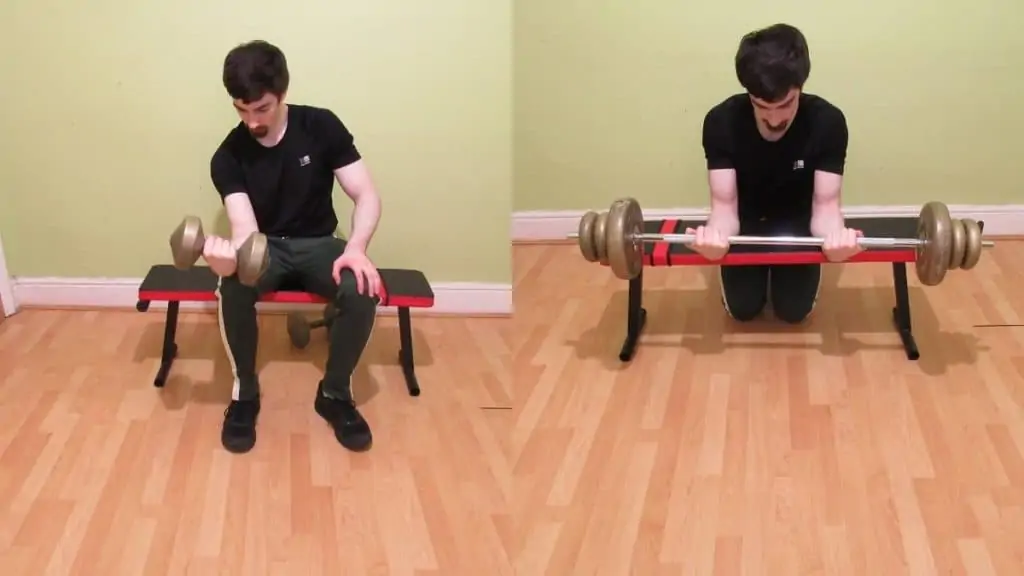
This is the best forearm workout for mass and size. We begin by pairing wrist curl variations together for the biggest pump possible before moving onto reverse curls to beef up the brachioradialis.
To finish off the forearms, we’re doing the wrist roller, which also makes for a great forearms workout by itself.
1A: Wrist curl (barbell) — 3 x 8-12 reps
1B: Reverse wrist curl — 3 x 15-20 reps
2: Reverse curl (thumbless grip) — 4 x 8-12 reps
3: One arm dumbbell wrist curl — 2 x 20 reps
4: Wrist roller (extensor focus) — 2 sets of max rounds to failure
Forearm strength workout
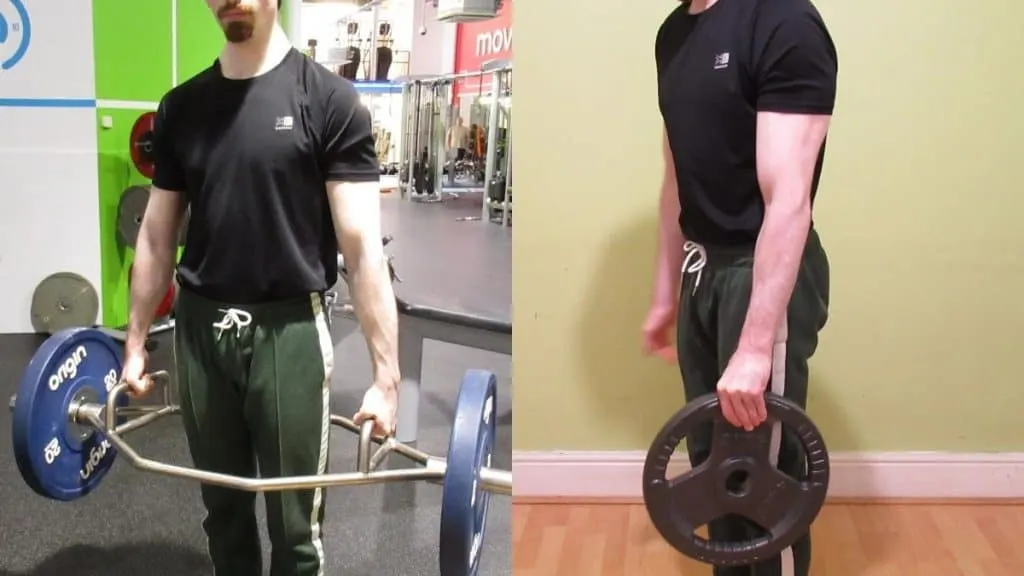
If you want a crushing handshake and equally freaky forearms, then this is the forearm exercise routine for you. It contains some of the best forearm exercises for mass as well as movement that will help you to develop formidable gripping and pinching strength.
1: Plate pinch — 3 x 30 second holds
2: Single dumbbell wrist curl — 4 x 8-10 reps
3: Reverse forearm curl — 4 x 15-20 reps
4: Farmer’s carry — 3 x 30-45 second carries
How to workout your forearms correctly and safely
Learning how to build forearm strength and mass doesn’t need to be complicated. If you follow these 4 simple tips, you’ll build new muscle while staying injury-free, providing that your diet and recovery are good.
Always use good form

It’s obvious, but it bears repeating. If you use poor form, then you’re more likely to get injured. And when you’re injured, you won’t be doing any forearm workouts.
If in doubt, slow down your reps—especially on the eccentric portion. This technique will naturally result in more time under tension, which is actually one of the best ways to ignite new muscle growth without lifting additional weight.
Find the best forearm workout for your goals
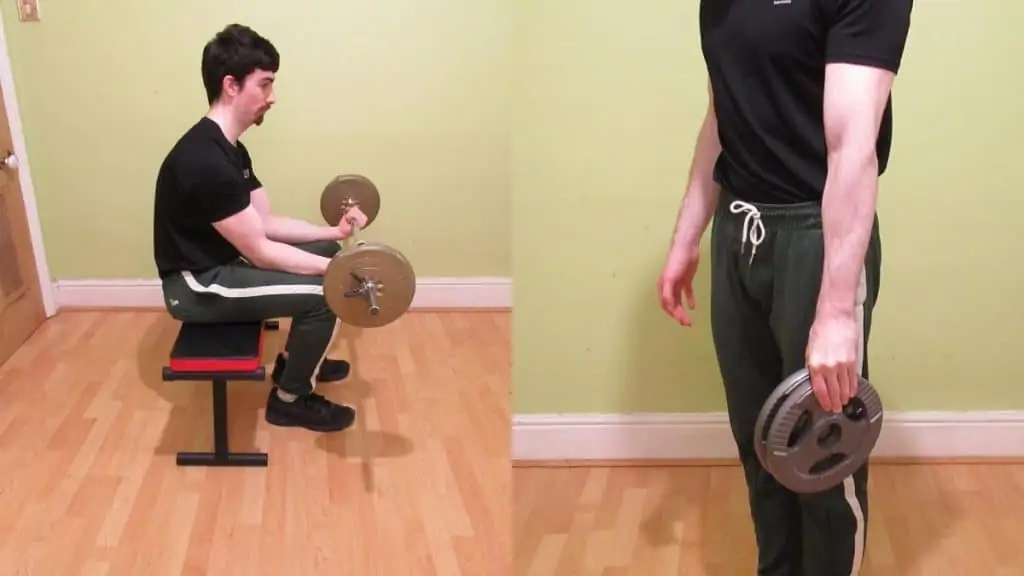
If your main goal is to get a firmer grip, then stick to forearm strength exercises like loaded carries and plate pinches. These exercises build size, too (and plenty of it at that). However, people generally do them for their grip and see the size gain as a nice perk.
On the other hand, when learning how to train forearms for maximum mass, it’s crucial that you realize the importance of dynamic contractions, which is to say, exercises that have both a lifting phase and a lowering component to them. [1]
Unlike isometrics, repetitive dynamic contractions have been shown to build more muscle mass.
For best results, however, you might wish to combine grip work with more traditional bodybuilding style exercises.
Learn how to work out your forearms without overtraining
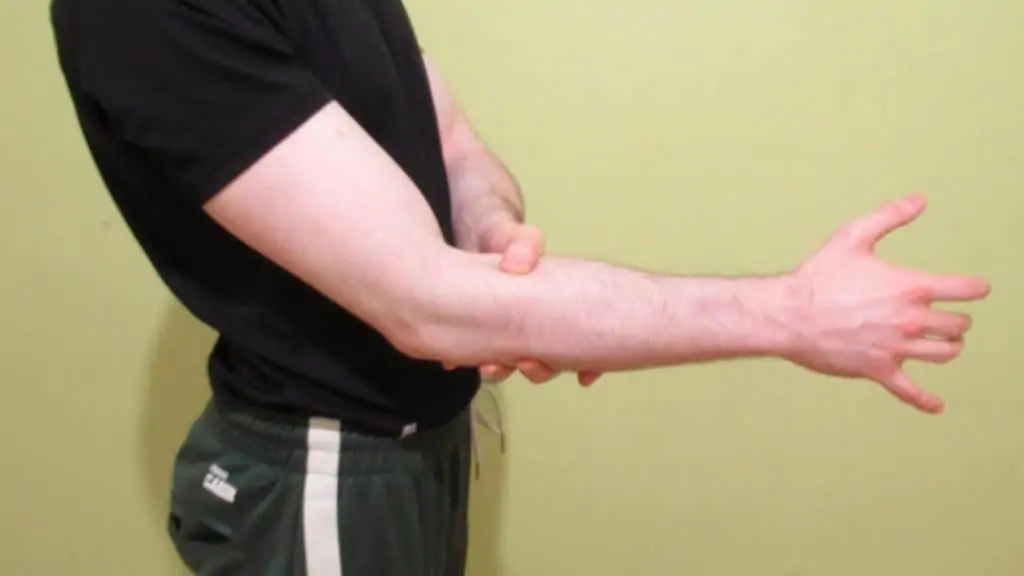
Muscles get stimulated in the gym, but they don’t grow in the gym. Rather, they increase in size when you rest them and feed them.
Therefore, it’s essential to take adequate time off between forearm workouts. For this reason, I recommend training your lower arms no more than twice a week.
Never neglect your grip
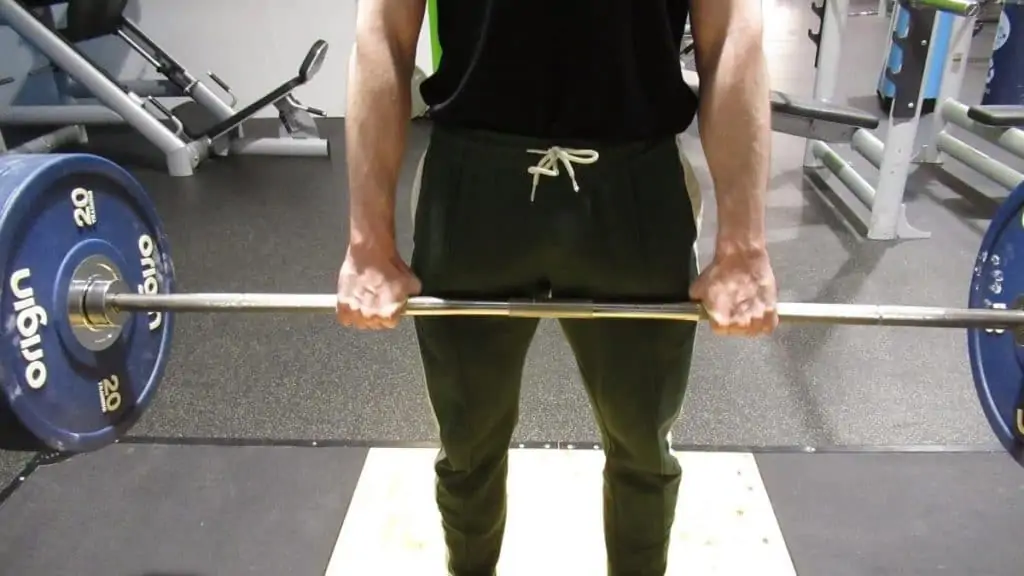
As I’ve already heavily alluded to, don’t neglect your grip if you want to build muscle. [2] Having a strong grip will make it easier to lift heavier weights on your other forearm exercises.
Forearm training FAQ
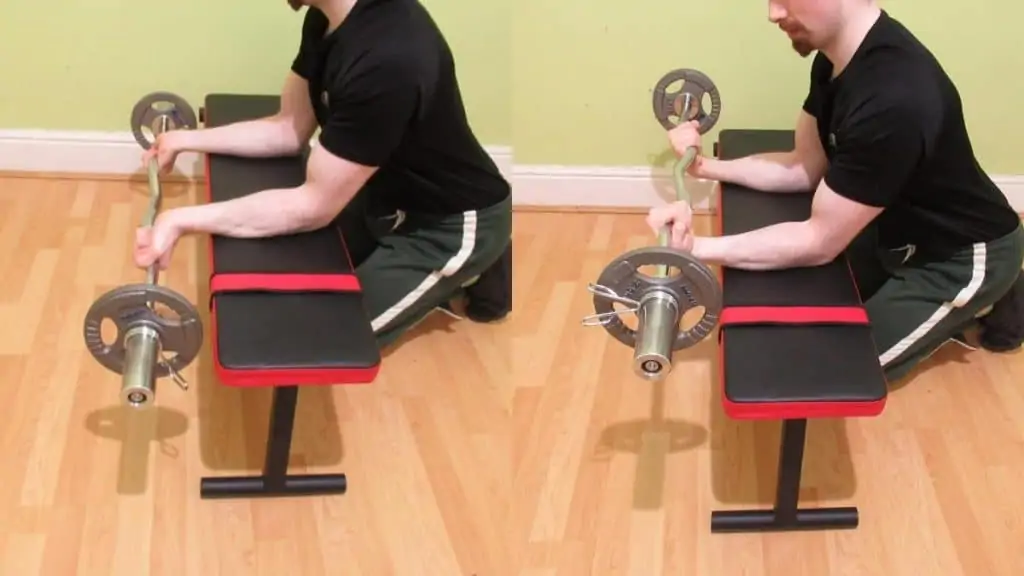
What are some good exercises for forearms?
The barbell wrist curl—any variation of it—is widely considered one of the top lower arm exercises because it allows you to lift high loads (relative to dumbbells and cables).
On the other end of the spectrum, the forearm twist is a great training drill because it gives your muscles an incredible pump by recruiting the remaining slow-twitch muscle fibers at the end of a tough session.
What is the single best forearm exercise?
I’d say that the single best forearm exercise for mass is the behind the back wrist curl for all the reasons that I outlined at the start—high loading potential, efficient execution, conduciveness to a strong mind-muscle connection.
What are the best forearm exercises for mass?
Any exercise that allows you to lift heavy loads has excellent mass building potential. The primary determinant for mass gain, however, is training volume and proximity to muscular failure. So in this regard, any exercise can build size as long as you train hard and recover.
Where can a beginner learn how to build forearm muscle?
This article, and the hundreds of others on our website, are a good starting point because we draw on the latest science as well as our years of industry experience.
A beginner should focus on forearm routines that have a simple exercise selection. This way, they can become stronger (and thereby bigger) from the basics rather than getting preoccupied with the latest training techniques promoted by fitness gurus.
What are some good forearm strengthening exercises for intermediates?
I like using a mixture of equipment in the forearm workout routines of intermediates so that they can achieve new muscle growth by hitting their lower arms from different angles. I’ll generally start with barbell wrist curls for low reps and then move onto cables to really hammer those slow-twitch muscle fibers that are so often neglected.
Can you tell me how to increase my forearm strength?
Focus on your grip strength. Use mainly low to moderate reps (except for extensor work) and eat enough quality calories to support your growth and recovery. Also, train consistently.
Where can I find other good workouts for forearms?
I’m obviously a bit biased, but we have many good forearm workouts for men, women, and all kinds of people on our website. So if you liked this guide, then you might also want to check out these other, more specific forearm workout routines.
- Bicep and forearm workout
- Bicep tricep and forearm workout
- Bodyweight forearm exercises
- Dumbbell forearm exercises
- Resistance band forearm exercises
- Forearms workout at home
- Forearm workout for women
- Forearms workout with a backpack
- Shoulder and forearm workout
Conclusion: Creating good forearm workouts for the gym
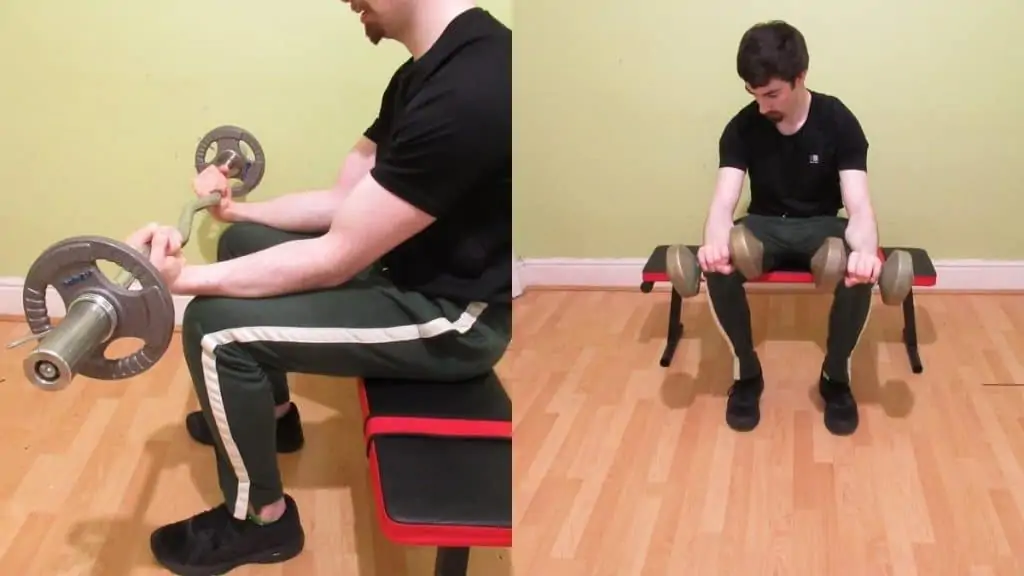
We’ve covered some of the best forearm exercises for mass and strength in this guide. But like anything in fitness, the best forearm workouts for you will depend on which exercises you most enjoy and how often you want to hit the gym.
For example, if you dislike training with barbells, then you’ll want to stick to dumbbells and cables.
Likewise, if you already do plenty of back and bicep training (which heavily work the forearms), then you might want to do fewer exercises and just focus on quality sets and reps since you’ve probably already got a good work capacity. [3]
As always, don’t neglect your recovery. You don’t want your forearm training to interfere with your other lifts, so it’s critical to allow for plenty of time off between sessions.
References
- Duchateau, J., & Hainaut, K. (1984). Isometric or dynamic training: differential effects on mechanical properties of a human muscle. Journal of Applied Physiology, 56(2), 296–301. https://doi.org/10.1152/jappl.1984.56.2.296
- Wind, A. E., Takken, T., Helders, P. J. M., & Engelbert, R. H. H. (2009). Is grip strength a predictor for total muscle strength in healthy children, adolescents, and young adults? European Journal of Pediatrics, 169(3), 281–287. https://doi.org/10.1007/s00431-009-1010-4
- Berg, O. K., Nyberg, S. K., Windedal, T. M., & Wang, E. (2018). Maximal strength training-induced improvements in forearm work efficiency are associated with reduced blood flow. American Journal of Physiology-Heart and Circulatory Physiology, 314(4), H853–H862. https://doi.org/10.1152/ajpheart.00435.2017

